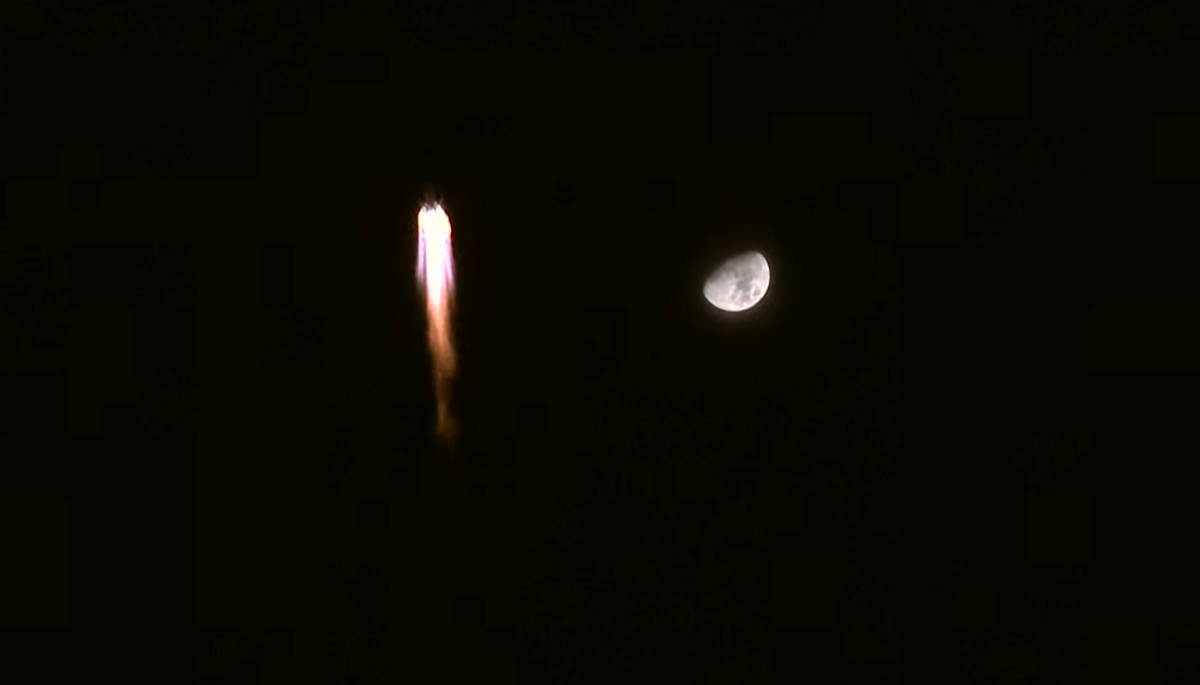
A Long March 2F carrying Shenzhou-13 rising against the backdrop of the moon on Oct. 15, 2021. Credit: CCTV/framegrab
By Andrew Jones,
Published by Space News, 31 January 2024
HELSINKI — China’s experimental reusable spacecraft recently performed maneuvers to raise its orbit but is apparently yet to release objects as it did during previous flights.
A Long March 2F rocket lifted off from the Jiuquan Satellite Launch Center in the Gobi Desert Dec. 14, beginning the third flight of what is considered to be a Chinese spaceplane. Though little is known about the project, it is widely thought the spacecraft is analogous to the U.S. Air Force’s X-37B.
The spacecraft entered an initial 333 by 348-kilometer-altitude orbit inclined by 50 degrees. U.S. Space Force space domain awareness data shows the spacecraft made a burn around Jan. 20 to raise its apogee, or farthest point from Earth, to 597 km.
A week later, the orbit was circularized into a 602 by 609-km orbit. This activity mirrors the spacecraft’s second mission, which raised itself from a similar initial orbit into a near-circular 597 by 608-km orbit after nearly three months in space.
China has not provided any details of the spacecraft nor updated on the mission, beyond the terse state media text published on the day of launch.
The spacecraft is seen as China’s attempt to develop similar capabilities to the X-37B.
“Based on what little information we have, I think the Shenlong [Chinese spaceplane] and the X-37B are likely doing many of the same missions,” Brian Weeden, Director of Program Planning at the Secure World Foundation, told SpaceNews in December. “That is, primarily being used for experimenting and testing new technologies, sensors, and perhaps even operational practices.
No satellites deployed — yet
Contrary to previous reports, there is no evidence as yet of the spaceplane releasing objects into orbit. Deployment of a subsatellite into orbit could follow the recent maneuvers, earlier experimental reusable spacecraft mission activities suggest.
The previous two missions saw the release of subsatellites that briefly transmitted signals. The second flight released its subsatellite after reaching its higher orbit.
The Chinese spaceplane was reported by some media to have released six satellites into orbit. Those reports were based on amateur spacecraft trackers suggesting that one of the objects other than the spaceplane were transmitting signals.
Six objects associated with the launch were cataloged in orbit. Five other objects were the Long March 2F upper stage and likely four pieces of debris typically associated with Long March 2F launches.
One of the spacecraft trackers later provided an update suggesting that a minor timing issue had led the trackers to mistake signals sent by a group of Chinese Yaogan reconnaissance satellites as being emitted by a piece of debris associated with the spaceplane.
Three of the four pieces of debris reentered the atmosphere earlier in January, according to U.S. Space Force tracking data. The final piece is expected to reenter and burn up in the coming days. The upper stage is predicted to reenter in March, with a large window of uncertainty.
Spaceplane mysteries
The spaceplane has been in orbit for 48 days during its third mission. Its first mission lasted just two days before landing at Lop Nur air base. The second mission—apparently demonstrating reusability—saw it orbit for 276 days, landing on May 8, 2023.
The gap between the spacecraft’s first and second missions—launching in 2020 and 2022 respectively—was one year and 11 months. The third mission saw a seven-month turnaround.
China has revealed no details of its experimental reusable spacecraft project. No images of any of the launches have been published. The spacecraft is launched vertically on a Long March 2F, a rocket used to launch China’s Shenzhou crewed missions.
The launcher has a payload capacity of just over eight metric tons to low Earth orbit. This suggests that the spacecraft could be somewhat similar in size and function to U.S. Air Force’s X-37B spaceplane.
This notion is reinforced by apparent images of the payload fairing wreckage recovered from the second launch and posted on the Sina Weibo social media site. The images give possible clues as to the dimensions and shape of the spacecraft.
Fairing of CZ2F rocket which launched CSSHQ on Aug 5 being openly exhibited in Henan Jiyuan No.1 middle school. If the bumps are spare spaces for wings, CSSHQ’s wingspan could be larger than fairing’s diameter 4.2m. HD: https://t.co/aPZ6MvDdZq Credit: TikTok Douyin@hnsjydyzx pic.twitter.com/6i3mXPvFLe
— CNSA Watcher (@CNSAWatcher) August 14, 2022
The reusable spacecraft may be the orbital segment which will operate in combination with a reusable suborbital first stage. A reusable suborbital spacecraft was tested for the first time in 2021. A second mission launched in August 2022. The suborbital craft uses a vertical takeoff and a horizontal landing.
The China Aerospace Science and Technology Corporation (CASC), the spacecraft’s developer, announced plans to develop a fully reusable, two-stage-to-orbit (TSTO) space transportation system prior to its first launch. CASC’s spaceplane project acquired national level funding from the Natural Science Foundation of China in 2022.
Meanwhile the U.S. Space Force X-37B spaceplane launched on its seventh mission Dec. 28. Flying on a Falcon Heavy for the first time, space activity watchers suggest the spacecraft was sent to a highly elliptical, high inclination orbit, and to a much higher altitude than previous missions. The secretive and autonomous X-37B reusable vehicle began flights in 2010.
See: Original Article




